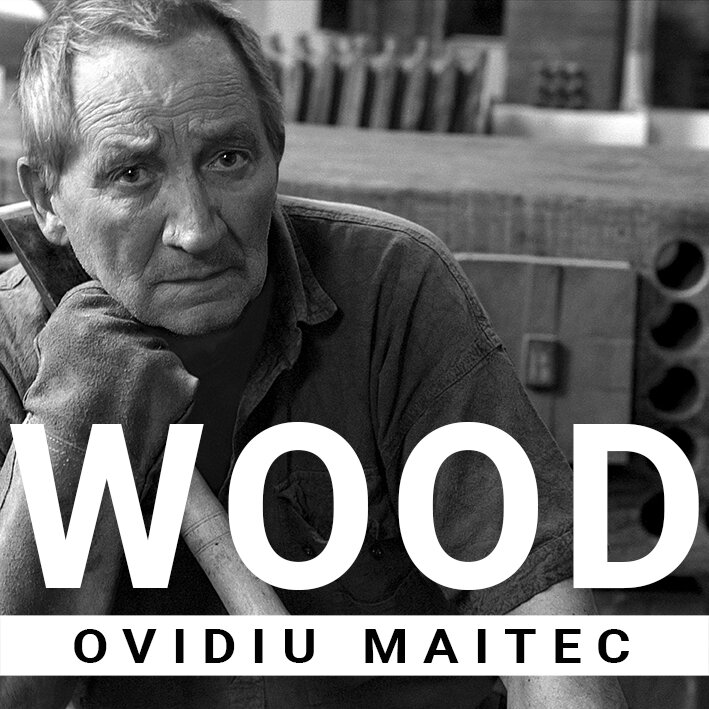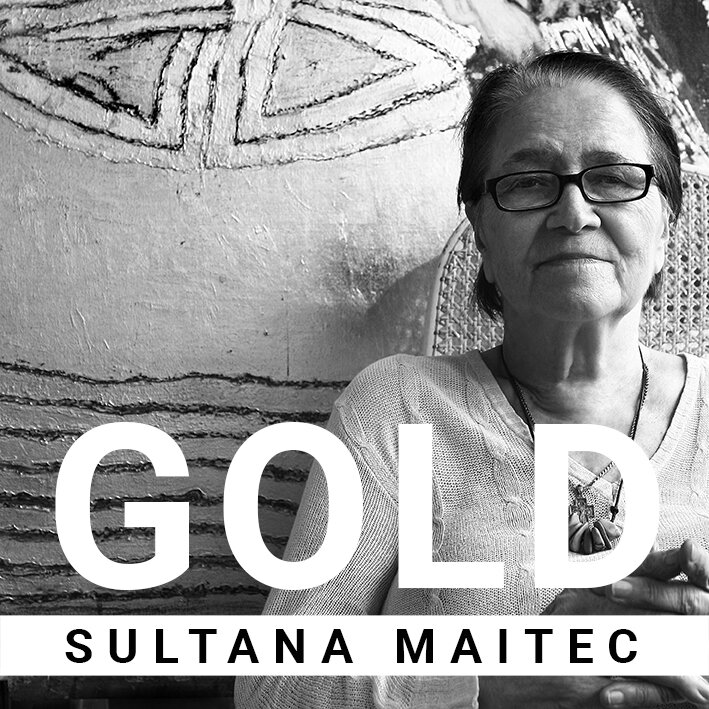OVIDIU MAITEC
Ovidiu Maitec was born in Arad in 1925. He studied sculpture at the Nicolae Grigorescu Institute of Plastic Arts, Bucharest, graduating in 1950. From 1950 to 1956, he was a teaching assistant in the Artistic Anatomy department of the Institute. He made his debut in 1953, but the real beginnings of what was to become his visual hallmark came in 1961-62, when, after a revelatory trip abroad, he made his first woodcarving, The Wall, a veritable manifesto of his new technique, whereby he distanced himself from figurative realism and began to explore non-figurative kinetic sculpture, in an expressionist manner at first, then in a constructivist-minimalist key, introducing perforation as a technical innovation. In 1968, he took part in the Venice Biennale, exhibiting in the Romanian Pavilion. The Biennale was to open up extraordinary opportunities for an artist coming from the Communist Bloc: a year later, he held his first solo exhibition, at the Circle Gallery in London, garnering highly positive reviews in prestigious publications that included International Herald Tribune, Arts Review, and Arts and Antiques Weekly. In 1971, celebrated gallerist Richard Demarco selected him as part of his Romanian Art Today exhibition at the Edinburgh Festival. At the festival Ovidiu Maitec met Jim Ede, a famous British collector, who invited him to exhibit at Kettle’s Yard, Cambridge, in 1973. It was also thanks to Ede’s special interest in Maitec’s work that Angels was subsequently purchased by the Tate Gallery. It was in this way that Britain became the country where Maitec was to exhibit most often in the years that followed. After the Kettle’s Yard show, he held solo exhibitions at the Richard Demarco Gallery, Edinburgh and the Bluecoat Gallery, Liverpool, in 1974, and at the Alwin Gallery, London, in 1977. The same year, he met Mircea Eliade in Paris, who was later to write that Ovidiu Maitec was the most powerful spiritual descendant of Brancusi, and that he was the man who had succeeded in “introducing light into matter.”
Exceptionally, given the particularities and the constraints of the period, Ovidiu Maitec took part in the Venice Biennale three times before 1989: after his participation in 1968, he exhibited there in 1972 and 1980, and returned in 1995. His trips to Europe and South America in the early 1960s radically changed his view of art. There followed personal and group exhibitions in Romania, international biennales and art events, and group exhibitions in Prague, Bratislava, Budapest, Belgrade, Berlin, Athens, Ankara, Istanbul, Damascus, Moscow, Paris, Helsinki, Rome, Hamburg, Stockholm, Teheran, London, Cairo, Stuttgart, New Delhi, Medellin, and elsewhere. His first solo show in Romania was held at the New Gallery, Bucharest, in 1976, and in 1985 his exhibition at the Salle Dalles brought together all his major sculptures.
On Christmas Eve 1989, during the Romanian Revolution, as a result of crossfire in the area of Romanian Television, Ovidiu Maitec’s studio was almost completely destroyed in a blaze, a tragedy that left a deep mark on the artist’s life. In the fire were lost around seventy wood and bronze sculptures, his library, his tools, and a large part of his personal archive, including his correspondence with Jim Ede. “Never in the depths of our being, in our eyes left open in amazement and sleeplessness, have there combined, never have there mingled so much joy and pain, so much horror, blood, ash, and rubble, despair and hope. Never have I seen history so close, so physical, incandescent and true,” wrote the artist in January 1990. Shortly thereafter, Ovidiu Maitec was invited to Paris by the French Ministry of Culture, which placed at his disposal a studio and a public commission. The shock of the loss of his studio brought about a change of vision in the final phase of the sculptor’s career, which he presented in solo exhibitions at the Catacomb Gallery, Bucharest, in 1996, the Arad Museum, in 1998, the National Art Gallery of Romania, Bucharest, in 2011, and the House of the Romanian Academy, in 2006. Ovidiu Maitec died in Paris in 2007, a few months before the National Museum of Contemporary Art was to hold the exhibition Bitzan, Maitec, Mitroi, Nicodim, curated by Mihai Oroveanu. The exhibition was subsequently shown at the gallery of the Romanian Cultural Institute, London, with the title Four Faces of Modernity: Bitzan, Maitec, Mitroi, Nicodim, in 2011.
His works can be found in prestigious museums and public and private collections in Romania, including the Romanian National Museum of Art, the National Museum of Contemporary Art, and fifteen public museums, and in numerous museums internationally, including the Tate Gallery, London; Kettle’s Yard, Cambridge; the Museum of Contemporary Art, Sydney; the Fond National d’Art Contemporain, Paris; the Richard Demarco Collection, Edinburgh; the Lennon Foundation, United States, the Städtische Kunsthalle, Mannheim, Germany; Norrköping Museum of Art, Sweden; Tyles Collection of Modern Art at the University of Tasmania, Australia; Baunkunst Galerie, Cologne, Germany; Manufactures Hanover, East West Trade Branch; and in private collections in the United Kingdom, Sweden, France, Italy, Germany, Switzerland, Greece, the United States, Columbia, and elsewhere. He received numerous awards, including the Romanian Academy Prize in 1967, followed by the Grand Prize of the Union of Plastic Artists in 1974, the Order of Cultural Merit in 1975, the Cavaliere al Merito della Repubblica Italiana in 1985, and the National Order of the Star of Romania to the rank of officer in 2000 and knight in 2007. Ovidiu Maitec was a member of the Romanian Academy, the Union of Romanian Fine Artists, and the Maison des Artistes, France.



